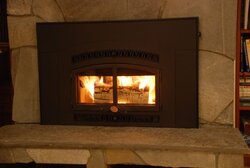The handyman friend who will be installing our insert has not done this kind of thing before, but he's handier than I am and has tools etc. We have just looked over all the components.
The liner kit says to install per manufacturers specs, though it didn't seem to come with any. - will call them tomorrow because they are not open today.
Couple particular questions maybe someone can help with:
The collar/adapter that will connect to the liner and go into the stove - looks like it will need a notch cut out where the damper comes through, and the inside of the stove collar has one stop on one side to keep the adapter from going in too far. Does the whole thing get cemented in there with stove cement to seal it in there solid or should it sit looser?
Where the liner attaches to that same collar, is that done with screws, and does it need cement or sealant too? Assuming that attachment is done last.
At the top of the chimney, we have a flat plate that will sit on the chimney and the liner attaches to the inside of that, near the cap. The top of my chimney is not totally flat as it's got cement on it. Should he gunk up the bottom with a whole lot of silicone and then use some screws too? Is there something else that we should keep in mind when sealing that plate on there?
It appears that our continuous damper has bricks right on top of it and when he cuts the damper to get the liner through, a couple of the bricks will have to be removed to make room. Is that OK? We will install the little plate about the fireplace not being suitable for regular fires, yada yada.
The liner kit says to install per manufacturers specs, though it didn't seem to come with any. - will call them tomorrow because they are not open today.
Couple particular questions maybe someone can help with:
The collar/adapter that will connect to the liner and go into the stove - looks like it will need a notch cut out where the damper comes through, and the inside of the stove collar has one stop on one side to keep the adapter from going in too far. Does the whole thing get cemented in there with stove cement to seal it in there solid or should it sit looser?
Where the liner attaches to that same collar, is that done with screws, and does it need cement or sealant too? Assuming that attachment is done last.
At the top of the chimney, we have a flat plate that will sit on the chimney and the liner attaches to the inside of that, near the cap. The top of my chimney is not totally flat as it's got cement on it. Should he gunk up the bottom with a whole lot of silicone and then use some screws too? Is there something else that we should keep in mind when sealing that plate on there?
It appears that our continuous damper has bricks right on top of it and when he cuts the damper to get the liner through, a couple of the bricks will have to be removed to make room. Is that OK? We will install the little plate about the fireplace not being suitable for regular fires, yada yada.


